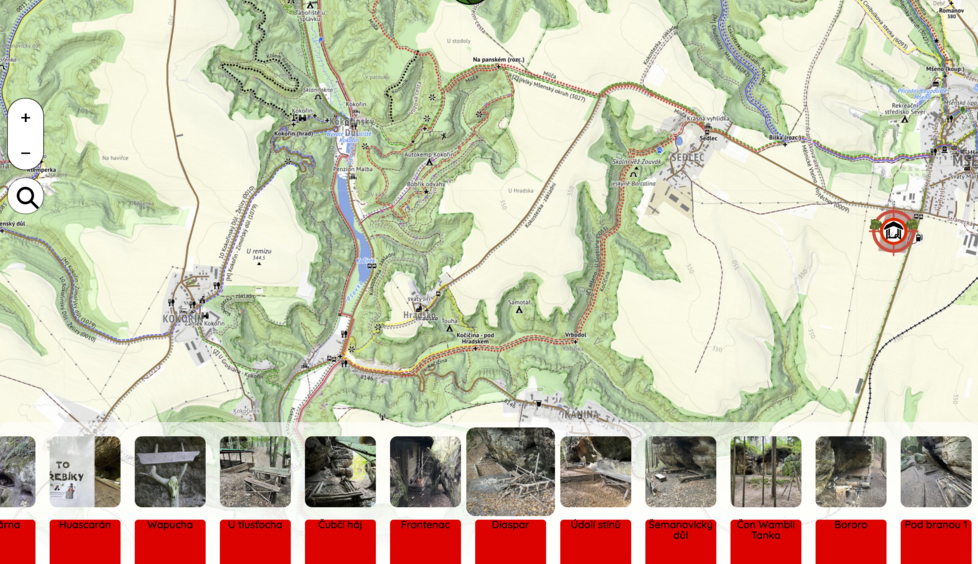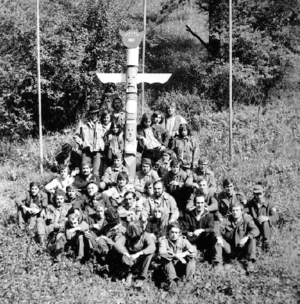In this project, I examine tramp camps and their current destruction, specifically in the Kokořínsko area in the north of the Czech republic. Due to the creation of the website trampskekempy.cz, on which all the camps were published, they were exposed and their destruction began. In this research, I address this issue, the suppression of tramping, and the destruction of places that are highly symbolic and closely linked to tramping. With this project, I would like to share how important these places are, why they are important, and why we should not lose them. In the future, I would also like to participate in an attempt to save these places. This research is the first step on this journey.
My parents are long-time tramps, and I am grateful to them for everything they have taught me and for the loving home they have created. From an early age, I grew up in a house full of tramp music and good spirits, and I realized how important it is to be there for each other. My family also includes a large group of Tramp friends who help each other, and they taught me what true friendship is all about. The forest has become my second home, and the smell of fire is my favorite scent
Ivan Brezina, who owns the website Trampskekempy.cz, points out that these places are messy. According to him, tramps go to camps with the intention of partying with alcohol and lighting fires, which makes it very likely that a fire will break out. Unfortunately, he fails to realize that when the camps were a secret, such incidents did not happen. It is definitely not the tramps who are responsible, but young people and others who, thanks to the website, know where they can hide in the woods and do not follow any of the tramp rules. Unfortunately, it is the tramps who suffer as a result. Yet they are the ones who respect such places and know how to behave in the forest. At a time when the locations were secret, you had to be a tramp to find such places, or you had to find the campsite by pure chance. The tramps were not interested in public spaces for everyone, so the places were only visited by people who wanted to sleep in the forest with good intentions. The author who published the campsites unfortunately does not realize that he is working against himself, pointing out the high number of visitors while leaving the map of all campsites in the Kokořín region freely accessible.
The name is black rocks, rock that are covered in black smoke - first reaction to the website which some of article titles name - We don't want black rocks in the Kokořín.
The main pillar of tramping became the construction of settlements. Wooden shelters or log cabins served as refuges and could be used by any tramp. They were built in forests, mostly among rocks, where they were well hidden and not easy to find, as their location was known only to the tramps. Each settlement was given a name, which could describe the landscape or be taken from the name of the settlement's founder. The settlers took care of them, regularly repairing and maintaining them in good condition. Tramps always behaved decently in the settlements, and after their visit, there was no trace of them in nature. They restocked the wood they used for fire, covered the fire pits with clay, and poured water on them to prevent fires. They were very kind to each other and to the forest. The settlements also have their own chronicle, where everyone could sign that they had visited. Various stories and anecdotes from their travels are also written in the chronicles. It therefore serves as a non-transferable diary that does not belong to a person but to a place. The chronicle also describes its founding and is decorated with various talismans and drawings. It is the pride of the entire settlement. The camps were also decorated with so-called camrátko, small pieces of wood that were painted on. They served as souvenirs from various events, most often from the annual bonfire. In the past, the settlement was a sacred place where, upon joining, an oath was sworn on the settlement knife. New members had to undergo a trial period ceremony, which included, for example, lighting a fire with a single match.
Upon admission to the settlement, we received a so-called domovenka, which was a patch with the settlement's logo embroidered on it, which was then worn on the left sleeve as a symbol of membership in the settlement. The domovenka bore the abbreviation T. O., which stands for tramp settlement, and below it was the name of the specific settlement.
Tramping as a movement emerged after the war, partly as a reaction to it, mainly as a weekend return to nature, an escape from the gray of city life. Its main sources can be considered craft scouting, American literature, and films of the 1920s. Tramping was also closely linked to hiking, mountaineering, skiing, water sports, and other outdoor activities. It was also brought about by people's natural and practical desire for freedom and adventure. Reactions to urban lifestyles, unfavorable social conditions, and strict rule are common themes throughout the history of the tramping movement. During the first decade of tramping, all the river valleys around Prague were discovered. The Vltava was renamed the "Great River," the Sázava suddenly became the "Golden River," the Berounka became the "Old River," and the Kocába was nicknamed the "Snake River." A distinctive slang developed among the tramps, and annual bonfires, gatherings, and potlatches were organized. Columns appeared in magazines such as "Tramp," "Naše osady" (Our Settlements), and many others. Tramping gradually spread to Moravia and Slovakia, where it was brought by Czech tramps in the last third of the 1920s.1 The founding of the first settlement in 1919, named "Lost Hope" after the cowboy film "The Valley of Lost Hope," is most often considered the beginning.
Tramps are a group of people who are like family, united by their free spirit, love of nature, and appreciation of its beauty. Camps and settlements that they built themselves served, and still serve, as their shelter in nature. The foundation of this large family is friendship; anyone I meet in the woods dressed in green is my friend. It has become an unspoken rule that people are kind to each other and all evil is gone.









